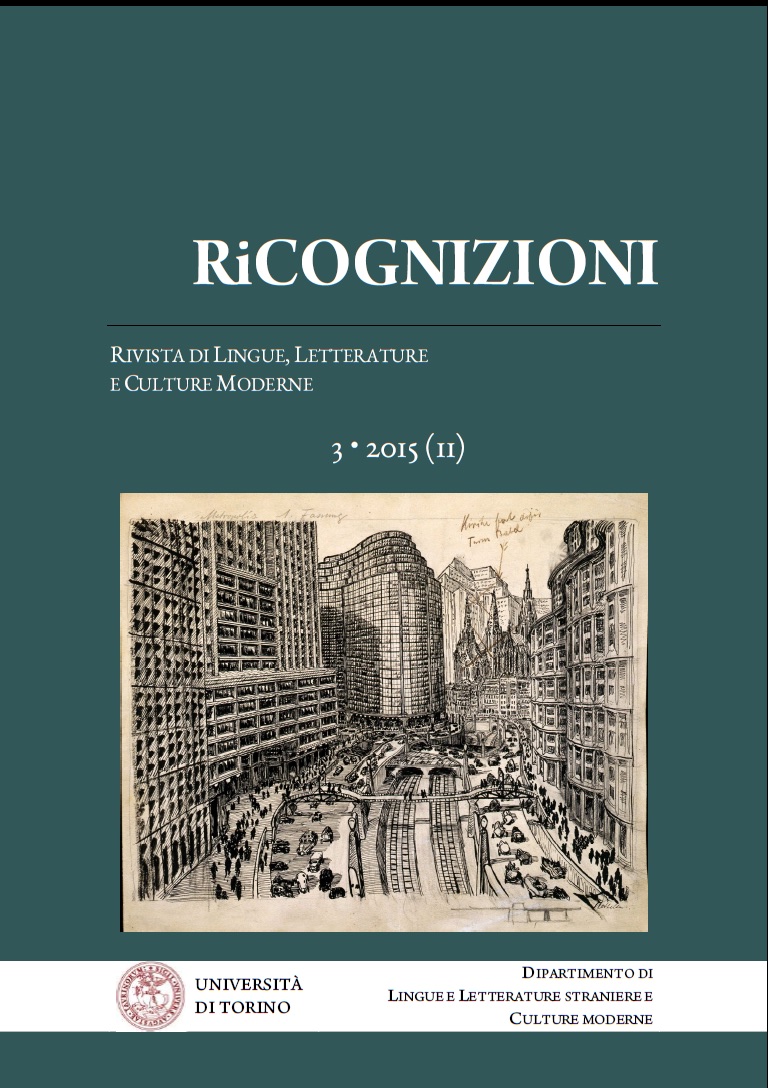Engendering the city. La rappresentazione di Shanghai attraverso le eroine del cinema cinese degli anni Trenta.
DOI:
https://doi.org/10.13135/2384-8987/865Parole chiave:
Shanghai, Women, 1930s Movies, WesternAbstract
This contribute has the aim to describe the representation of the city of Shanghai in Chinese film production during 1930s through some female roles because of the sympathetic relationship between Chinese women and the city in the filmic imaginary of that period. This relationship engenders the city that like female characters is subdued by Western invader and by the metropolitan violence that spread all over the streets. In some movie the female face is superimposed with the city creating a reflecting image that muffles the bad reputation of Shanghai as the “Oriental whore” .
production during 1930s through some female roles because of the sympathetic relationship between Chinese women and the city in the filmic imaginary of that period. This relationship engenders the city that like female characters is subdued by Western invader and by the metropolitan violence that spread all over the streets. In some movie the female face is superimposed with the city creating a reflecting image that muffles the bad reputation of Shanghai as the “Oriental whore” .
Riferimenti bibliografici
Bibliografia
Bao, T., Zhang, T., Liu, N., Mu, S., Ye, L., Shi, Z., (2013), Shanghai Suite, traduzioni a cura di Leonesi, B., Pisano, L., Stafutti, S., Viglione, C., Roma, Atmosphere libri.
Benjamin, W., (2007), Infanzia Berlinese. Intorno al Millenovecento, Torino, Einaudi
Boshier, R.W., Huang, Y., (2007) Untold story of foreign devil adult educators in Shanghai silk factories (1920 to 1949). Adult Education Quarterly, 57, 4, 329-345.
Dai, Y., (1999), Shanghai xiaojie, Shanghai, Shanghai Huabao chubanshe.
Dong, M. Y. (2008) Who Is Afraid of the Chinese Modern Girl?, in The Modern Girl Around the World. Consumption, Modernity, and Globalization, The Modern Girl Around the World Research Group, ed. by, Durham, Duke University Press, p. 194-195.
—————————(2003) Republican Beijing: The City and Its Histories, Berkely, Los Angeles, London,University of California Press.
Dos Passos, J., (1958) Nuova York, Milano, Dall’Oglio.
Gandini, L., (1994) L’Immagine della Città Americana nel Cinema Hollywoodiano (1927-1932), Bologna, Clueb.
Hansen, M. (2000) Fallen Woman Rising Stars, New Horizons: Shanghai Silent Film As Vernacular Modernism, in Film Quarterly, vol.54, n.1, University of California Press, p. 10-22.
Harris, K., (2003), Goddess: Fallen Woman of Shanghai in Chris Berry (edited by) Chinese Film in Focus, 25 New Takes, London, British Film Institute.
He, C., (2004) Henrik Ibsen and Modern Chinese Drama, Oslo, Unipub forlag.
Hershatter, G., (1999), Dangerous Pleasure: Prostitution and Modernity in Twentieth Century in Shanghai, Berkeley and Los Angeles, California, University of California Press
Hsia, C.T, (1961), A History of Modern Chinese Fiction 1917-1957, New Haven, Yale University Press.
Hua, F., (1929), Shanghai jiepou zhi yi – Faguo gongyuan de renshi, in Hong meigui n.32, vol.5.
Huang Z. , Xi N., Ke L. and Yao S., Comment on Night in the City (Chengshi zhi Ye ping), chenbao, 9 march 1933.
Lee, L. O., (1999), Shanghai Modern. The Flourishing of a New Urban Culture in China 1930-1945, Cambridge, Massachussetts, Harvard University Press
—————- (1987), Zhongguo xiandai xiaoshuo de xianquzhe, in «Lianhe wenxue» 3, no. 12, p.14.
Lethbridge, H. J., (1934-1935) All About Shanghai, an English-written city guidebook, Shanghai, University Press.
Mao, D., (1957), Midnight (1930), Peking, Foreign Languages Press.
Mu, S., (2004), Il Foxtrot di Shanghai, un Frammento (1933), traduzione di Masci, M., Milano, Aldelphi.
Palmero, P., (1991) Apologia dello Smarrimento, in Palmero, P., Terranova, A. (1994), Abitare l’Immaginario. Forme e Rappresentazioni della Metropoli, Torino, Celid.
Pan, L. (1982) In Search of Old Shanghai, Hong Kong, Joint Publishers Co.
Park, R., (1925) The City. Suggestions for the Investigation of Human Behavior in the Urban Environment, in Hatt, P.K. (a cura di), (1951) Reader in Urban Sociology, Glencoe/Illinois, The Free Press, p.19.
Sergeant, H. (1990) Shanghai: Collision of Culture, 1918-1939, New York, Crown Publishers.
Simmler, G., (2011) La metropoli e la vita dello spirito (1903), Roma, Armando Editore.
Shen, V., (2005), The Origins of Left-wing Cinema in China, 1932-37, New York, London, Routledge.
Sorlin, P., (1979), Sociologia del Cinema, Milano, Garzanti.
Sun, G., (1988), Jiu Shanghai chanji mishi (Secret History of Prostitution in Old Shanghai), Henan, Henan renmin chubanshe.
Xiao, Z. (1997), Anti-Imperialism and Film Censorship During the Nanjing Decade 1927-1937, in Sheldon H. (a cura di), Transnational Chinese Cinemas, Identity, Nationhood, Gender, Honolulu, University of Hawai Press, 1997, pp. 35-57.
Yeh, W. (2007), Shanghai Splendor. Economic Sentiments and the Making of Modern China, 1843-1949, Berkeley, University of California Press.
Wu, Y. (1986) Wo de tansuo he zhuiqu, Zhongguo dianying chubanshe.
Zhang, Y., (1996), The City in Modern Chinese Literature and Film. Configurations of Space, Time and Gender, Stanford, California, Stanford University Press.
##submission.downloads##
Pubblicato
Come citare
Fascicolo
Sezione
Licenza
Gli autori che pubblicano su questa rivista accettano le seguenti condizioni:- Gli autori mantengono i diritti sulla loro opera e cedono alla rivista il diritto di prima pubblicazione dell'opera, contemporaneamente licenziata sotto una Licenza Creative Commons - Attribuzione che permette ad altri di condividere l'opera indicando la paternità intellettuale e la prima pubblicazione su questa rivista.
- Gli autori possono aderire ad altri accordi di licenza non esclusiva per la distribuzione della versione dell'opera pubblicata (es. depositarla in un archivio istituzionale o pubblicarla in una monografia), a patto di indicare che la prima pubblicazione è avvenuta su questa rivista.
- Gli autori possono diffondere la loro opera online (es. in repository istituzionali o nel loro sito web) prima e durante il processo di submission, poiché può portare a scambi produttivi e aumentare le citazioni dell'opera pubblicata (Vedi The Effect of Open Access).








